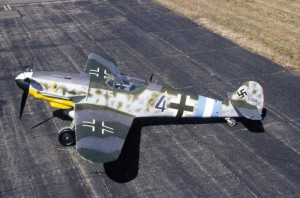04 Mar Luftwaffe

DAYTON, Ohio — Messerschmitt Bf 109G-10 at the National Museum of the United States Air Force. (U.S. Air Force photo)
Luftwaffe is the name for the German Air Force.
Although formidable opponents against the Allies, the German fighter planes had a smaller fuel capacity, so they couldn’t stay with the B-17’s for a long period of time. Toward the end of the war, the Allies were producing better fighters in huge quantities, and the Germans just couldn’t keep up.
The two German fighter planes that Herman mentions in his diary are the “FW” (Focke-Wulf Fw 190) and the ME 109. ( Messerschmitt Bf 109.)
The ME 109 was Germany’s most frequent fighter plane. In the battles against our allied airmen, the 109’s often provided top cover for the more heavily armed Focke-Wulf Fw 190’s attacking the bomber formations. According to the National Museum of the Air Force, the Messerschmitt Bf 109 is the most produced fighter plane in history. There is one on display at the National Museum, located near Dayton Ohio. Throughout the war, numerous enemy aircraft were brought to Wright Field in Ohio to face a rigid examination, including test flights.
Herman also encountered the JU 88, or the Junkers Ju 88, a German plane that was used both as a bomber and as a fighter. The German World War II bombers were smaller and had a shorter range than the “Flying Fortress” B-17’s. That is why they didn’t wage large-scale bombing attacks against England.
In his diary, Herman frequently refers to “Jerry,” a slang nickname used during World War II for the Germans.
“… Jerry would receive a just tribute to-day … a payment on account.”


Tom Sanor
Posted at 15:14h, 18 MarchYou say, “Their World War II airplanes were advanced but were for the most part two engine planes (unlike the 4 engine B17’s) so they were unable to fly as far…” This is mixing apples and oranges. If you are trying to describe the German BOMBERS it is true that ALL of their bombers were smaller and had a shorter range than the Allied bombers, therefore were less effective as BOMBERS. However if you are trying to describe the opponents to the B17, the German FIGHTERS, the most accurate statement after saying “advanced” would be that they were short in range (with small fuel capacity) which made them less effective (than Allied FIGHTERS, for example) because they couldn’t stay with the B17’s very long before fuel became an issue. The Germans used both 1 engine and 2 engine fighters (as did the Allies) but that had little to do with their effectiveness. Until late in the war the German fighters were equal to the Allied fighters EXCEPT FOR THEIR SHORT RANGE, but later in the war the Allies produced better fighters in huge quantities and the Germans could never overcome that disadvantage.
Pat
Posted at 08:02h, 19 MarchExcellent … I will revise the post to correct this. It’s too important. THANKS!